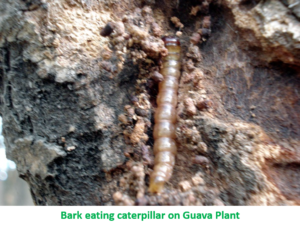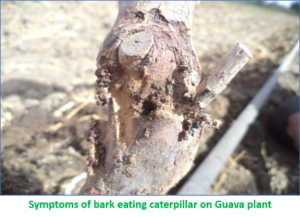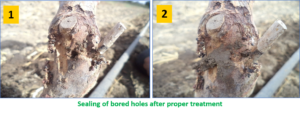< Back to Insects Management
Bark eating Caterpillar – Scientific Name > Indarbela tetraonis
What is Bark eating Caterpillar?
As the name suggest it is a caterpillar which lives and feeds on the branches and stem of the plants. Like, every caterpillar it is a one stage of Inderbela moth which hampers the economics in Agriculture.
Egg– The moths lay light brown spherical eggs in clusters in the cracks and crevices of the bark. After 7 to 11 days the eggs hatch into small neonate.
Larvae– The larvae moves out in search of food in the concealed places of shoots and bore a tunnel downward in to the wood. The tunnel is used as shelter during the day hours. While at night, the larvae come out and start feeding on the outer bark. This period last for another 27-298 days.
Pupa– This is a rest phase of it for growing itself in adult. The phase is conducted in the hole/tunnels made by them during its larval stage, while within 20-25 days of pupation it becomes an adult.
Adult– The male adults are smaller than female ones and also have shorter life span. This phase varies from 4-7 days.
How does it damage the plant?
The most damaging stage of the insect is larval stage. The larvae bore holes in search of food in the stem and branches which ruptures the tissue of the plant blocking the passage of food and water in the plant, which may be fatal for plant.
Symptoms
- Irregular tunnels and patches covered with silken web consisting of excreta and chewed up wood particles on the shoots, branches, stem and main trunk can be seen.
- Shelter holes may also be seen particularly at the joints of shoots and branches.
- The young shoots dry and die away giving a feeble look to the plants.
How to manage or control it?
- Maintaining cleanliness in the orchard is the thumb rule for any pest and disease infestation.
- Control is necessary during all the life cycle stages but the best control time is when eggs are hatching and caterpillars are small.
- A piece of wire inserted into the bored hole to kill the caterpillar inside can be quite effective in small orchards or when the infestation is low.
- In case of severe infestation a swab of cotton wool soaked in 0.5ml/l dichlorovos or injecting the same through bored holes can effectively control the same.
- Injecting kerosene oil in the hole has also been reported to be effective. Always seal the hole after any treatment with cotton of mud.
Disclaimer:
- Above contents are based on our own learning and experiences shared by VNR Bihi Guava Growers. We don’t intent to promote any chemical formulation directly or indirectly.
- The quality of chemical or other inputs stays with its manufacturers & vendors of same.
- Growers need to confirm above two points from its manufacturer & vendors of mentioned inputs.
- In case of any confusion or dilemma growers are suggested to consult technical team VNR Nursery or visit nearest KVKs (Krishi Vigyan Kedras) or Central or State Government Agricultural Universities & Research stations to address of their problems.














